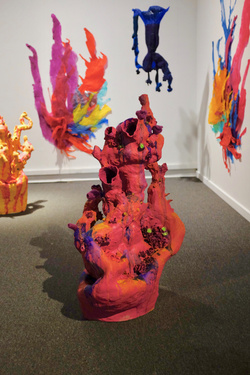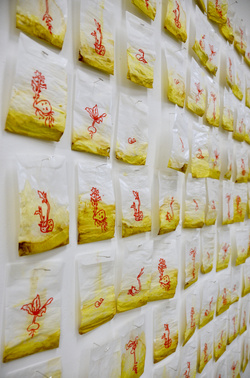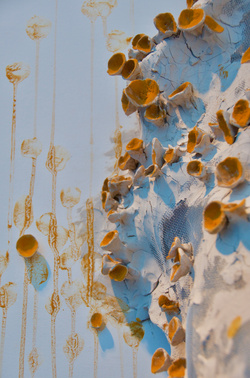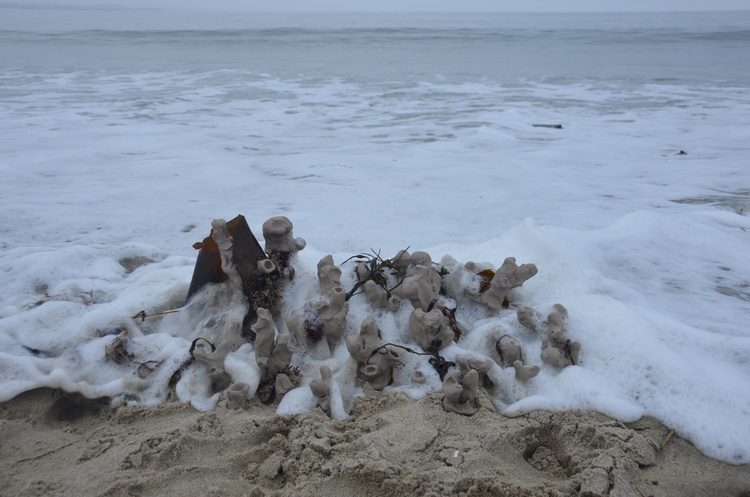Anela Oh: Molding Visions of Our Future
- pialu62
- Apr 14, 2021
- 5 min read
Last week, I was fortunate enough to speak with my childhood friend, Anela Ming-Yue Oh, about her experience as an artist, a woman, a mixed-race person, and a visionary of the world to come. We share a deep understanding about what it means to be between worlds; we are escaping boxes that are made not only to define us but also to confine our experiences and hide our agency over our experiences from us.

She gifted me with insight on her personal growth in these times of stress and fear. She gifted me with validating my own experience as a mixed-race woman of Asian descent in America and the intangible power that comes with making and creating. For these gifts, I thank her. I also thank you for taking the time to consider her personal experience and her creations as means to build a world that we can all thrive in and be proud of.
Anela grew up in a state of transience, having moved with her family every two to three years of her life. At the School of the Museum of Fine Arts at Tufts University, she was able to establish herself and a strong community structure for the first time. She offered an expansive technical knowledge of clay and what it demands of the ceramicist to her community. To serve others and to follow the growth of pieces and the people around her was comforting and energizing. Moving away from this community coincided with the emergence of the coronavirus and ultimately led her to experiencing isolation in a whole new way. She works in a studio alone, which is not normally how her residency at Sonoma Ceramics would have taken place. Typically, she would be able to see the process of other creators, learn with them, and experience the excitement and energy of those near her.

"I miss the community aspect of a shared community space, I miss that sort of energy. I miss going through things together."
Anela has been able to build a different system of support, even in these strange times of COVID-19. One way is through sharing meals with people. When her work or the stress of the world consumes her, they gave her food when she didn't have the energy to provide that for herself. After the domestic terrorist attack on Asian women in Atlanta, she felt she couldn't "be human" for a time.
"Oh, I am afraid in my body as an Asian woman, and that's like a phrase I never would have said as someone who is mixed-race before."
As people of mixed-race we have been gaslit into thinking we are protected by our "white" identity, and we just aren't. We don't pass as white, yet we must face our privileges head on; this balancing-act has been our struggle. Anela explains, "The spaces aren't made for you to exist in and of yourself," and regardless of the restrictions the world has put on us, we deserve to exist fully as ourselves. In our current society, there has been a massive shift to understanding our relationship with race and how we have been taught this concept of "otherness" and "whiteness". Our connections to these concepts, in the way the world has informed us in the past, steals away our true identities and, as a result, our agency over our experiences. Together, we will redefine these conceptions, among others, and give them new meaning to empower all of us who do not fit the old ways of thinking.

After a time of mourning and introspection, she had a surge of energy to create, so she did. It was a rapid process, too rapid for the clay to become strong enough to endure time without follow-up care. She wasn't emotionally able to get into the studio to take care of this piece, so it broke.
"It was really hard to make some days, and that was okay."
This piece broke into some usable and some unusable pieces. She is currently working to make finished products with the usable pieces, which are turning out beautifully, I might add. With the unusable pieces, she is letting them dissolve in water and become moldable clay, once again.
In my eyes, the story of this piece is poetic. For Anela, the lived experience with this piece allowed her to become resituated in her body. She says, "To know that we can make and build things is so much power." She finds her materials to be grounding. Clay and papermaking, which are her specialties, are highly process-based and demand a lot of physicality. These qualities make creating for Anela meditative and freeing. "We are working towards a constantly shifting future based on our actions now. Art-making is a way to access that power." Art-making has always been a place where Anela has been able to be unapologetic and to take up space.
Her freedom while creating preceded the steps of her personal growth. Creating is a lesson in self-acceptance and acknowledging her strengths not only as an artist, but also as a person. I asked her when this shift of freedom in her work began to translate to freedom in her life and her response was, "Well, I went to Malaysia."
She explained that artists of any interesting cultural heritage and people of color are constantly asked to speak on that one aspect of their life, even if their work isn't directly about it. And even when she shares her understanding of this she can be confronted with phrases like, "I don't think white people are going to get what you are saying." There was a demand in school and other settings in the States to explain that part of herself. After many years of art school, which started before high school for Anela, she grew exhausted of having to declare her cultural uniqueness when speaking about her work. When she was in Malaysia, she didn't have to conceptualize her generational trauma for other people, there was already an understanding of what it meant to have this shared history. She was able to rediscover her very real connection to this part of herself, which, as a mixed-person, can be very challenging.
"Now, I'm ready to talk about this in the ways I want to." she declared.

She will no longer allow the entire conversation of her work to be overtaken by the surface level explanation of her heritage of trauma. Instead she will direct the conversation towards deep-looking, the strength she draws from her ancestors and whatever the heck she wants it to be about. Period.
In Sonoma, there are cacti that have a hardened surface that has a similar form and function to bark on trees. When she first saw these cacti, she couldn't figure out what was going on. Were small cacti growing out of a tree? Could this be the cactus itself?
What she discovered was that this "bark" is an adaptation called "corking" where the cactus strengthens its base so that it can grow taller and broader. The cactus she was observing had used its energy stores to support its future growth. She is incorporating aspects of this cactus' adaptation into her work, visually and metaphorically. Anela implors us to support growth now for the possibilities of beauty in the future,
"We have to reimaging how we move forward from here, part of that is recognizing what is happening in our society right now. Some people use art to unveil that, for me, it's really taking what I know from my lived-experience as an Asian-American, as a mixed-race person to think about futures and imagine futures and possible beauty."
She suggests that we have to be transforming in the present. When I experience her work, I feel hope, I feel joy, I experience light differently and I feel connected to the strength and organic flow of incontrovertible energy that we all have to offer the world.
Anela Oh is currently at her first Artist in Residency program at Sonoma Ceramics in Sonoma, California. Her very first solo exhibit will be held starting on the first Friday of June 2021.
To see more of her work, learn more about her, or contact Anela:
Please visit her website https://anelaoh.com/
And follow her instagram @turmericandclay



















Comments